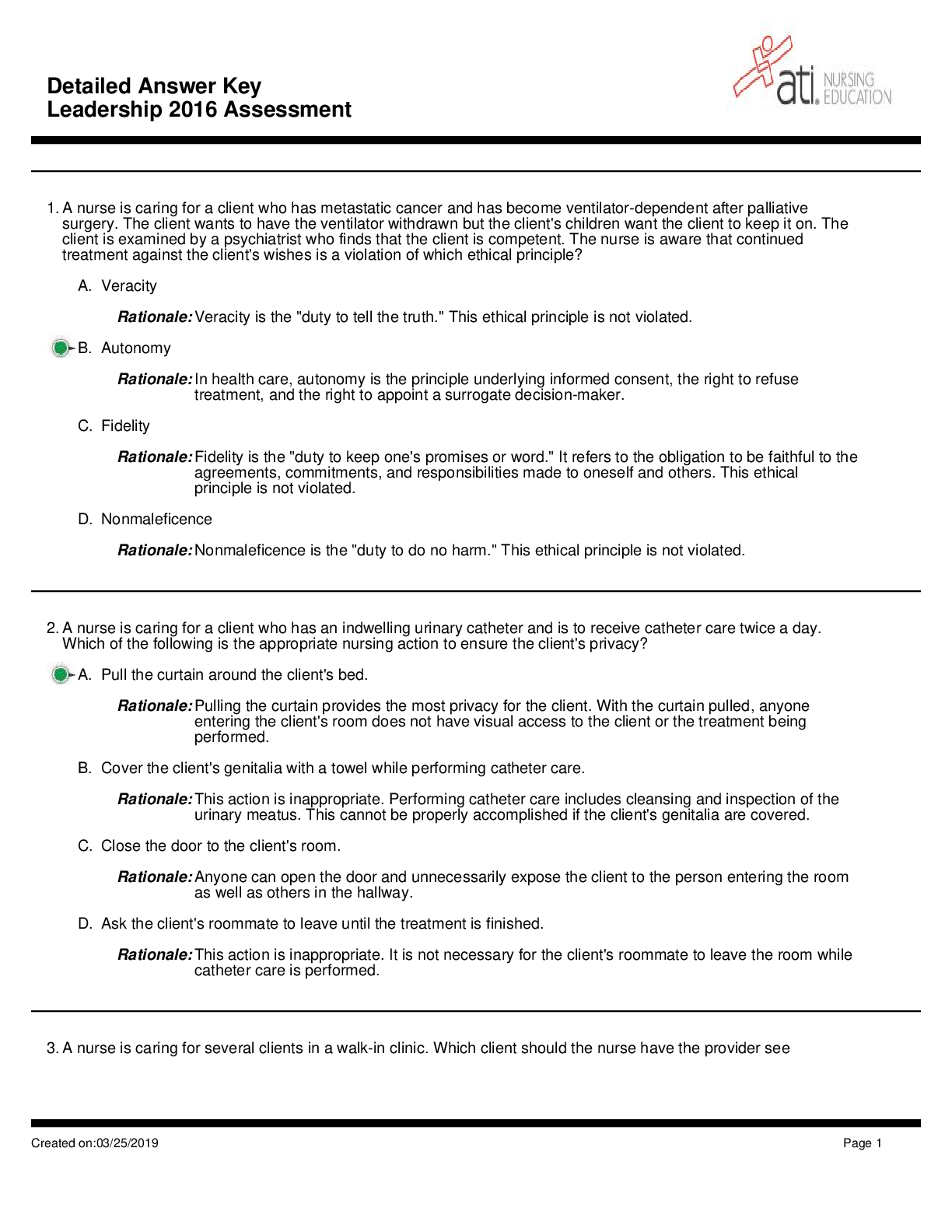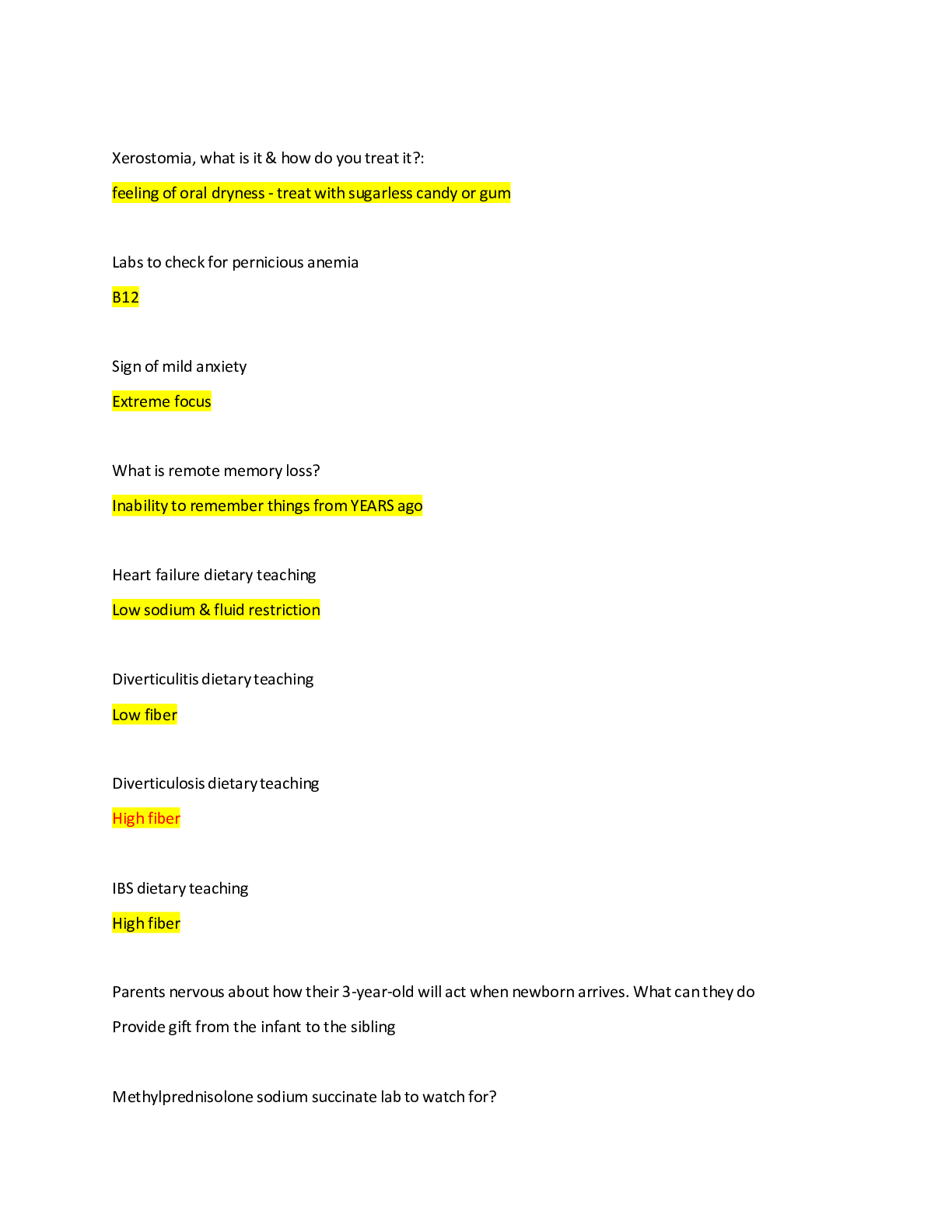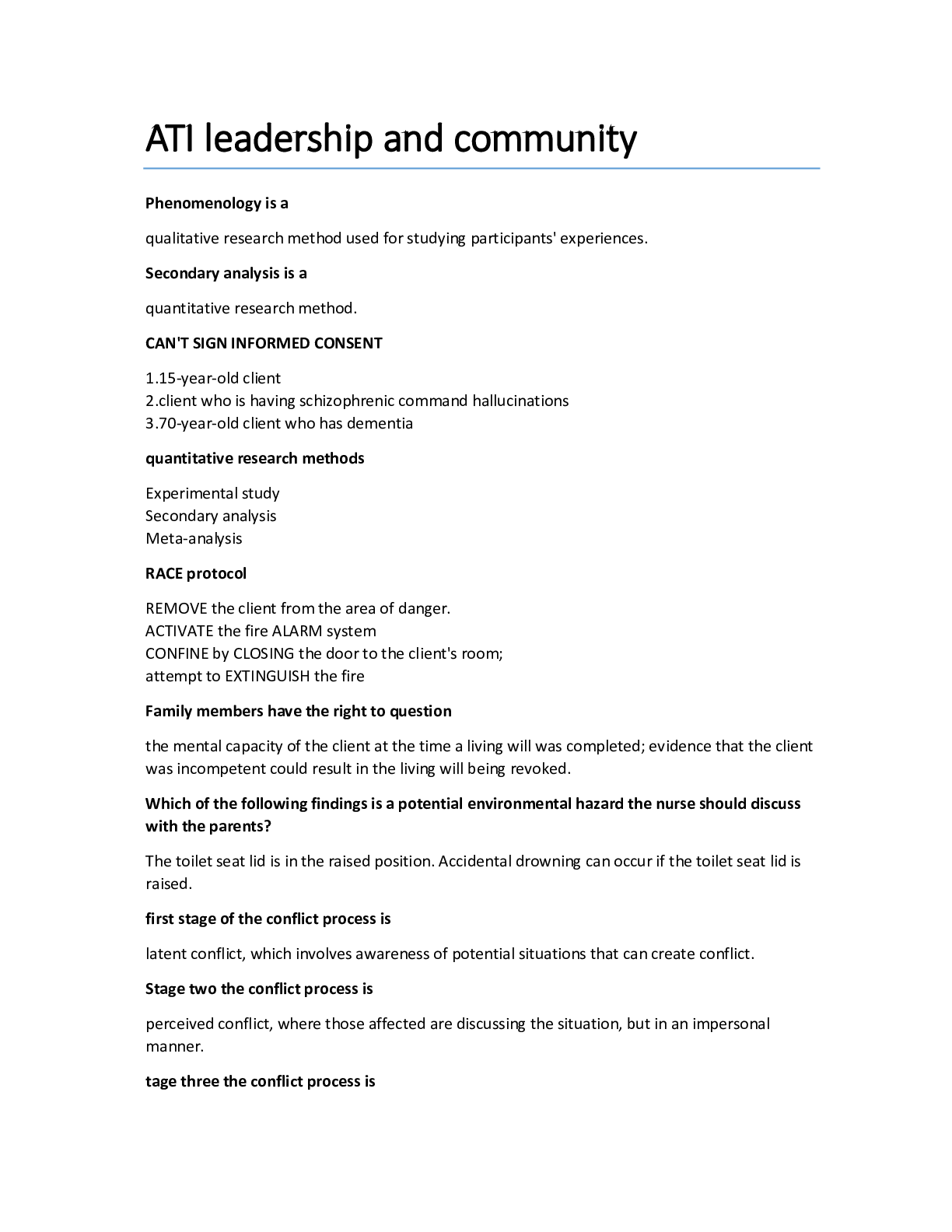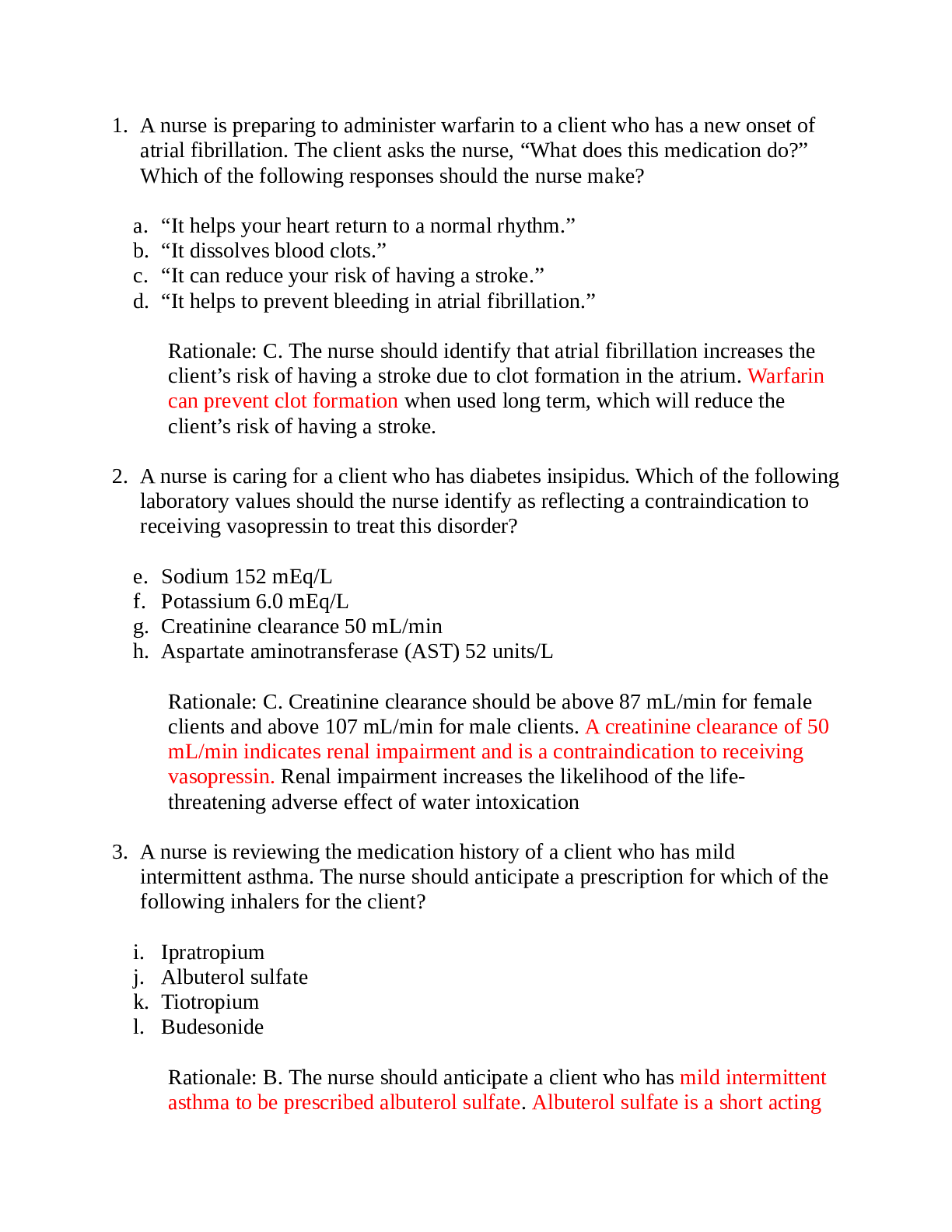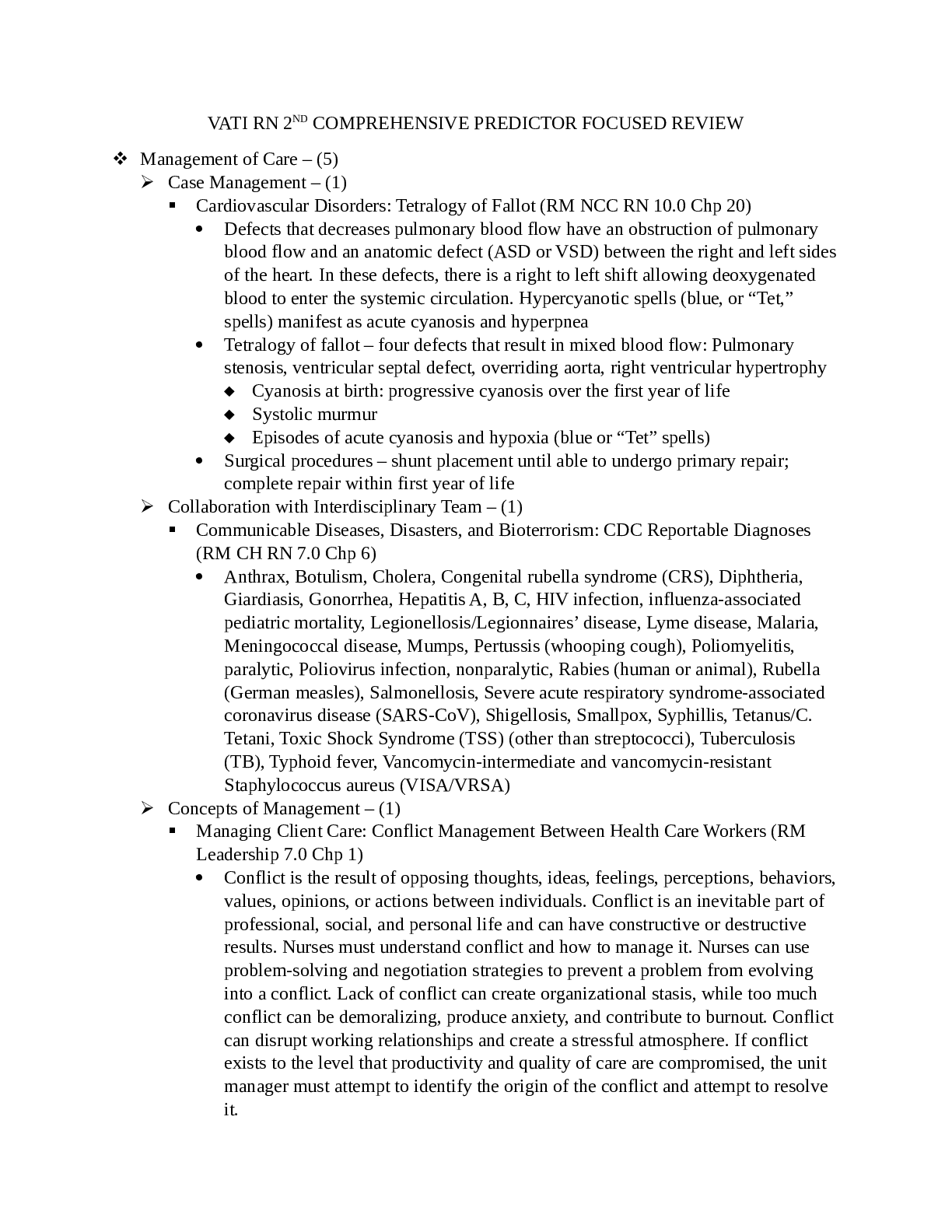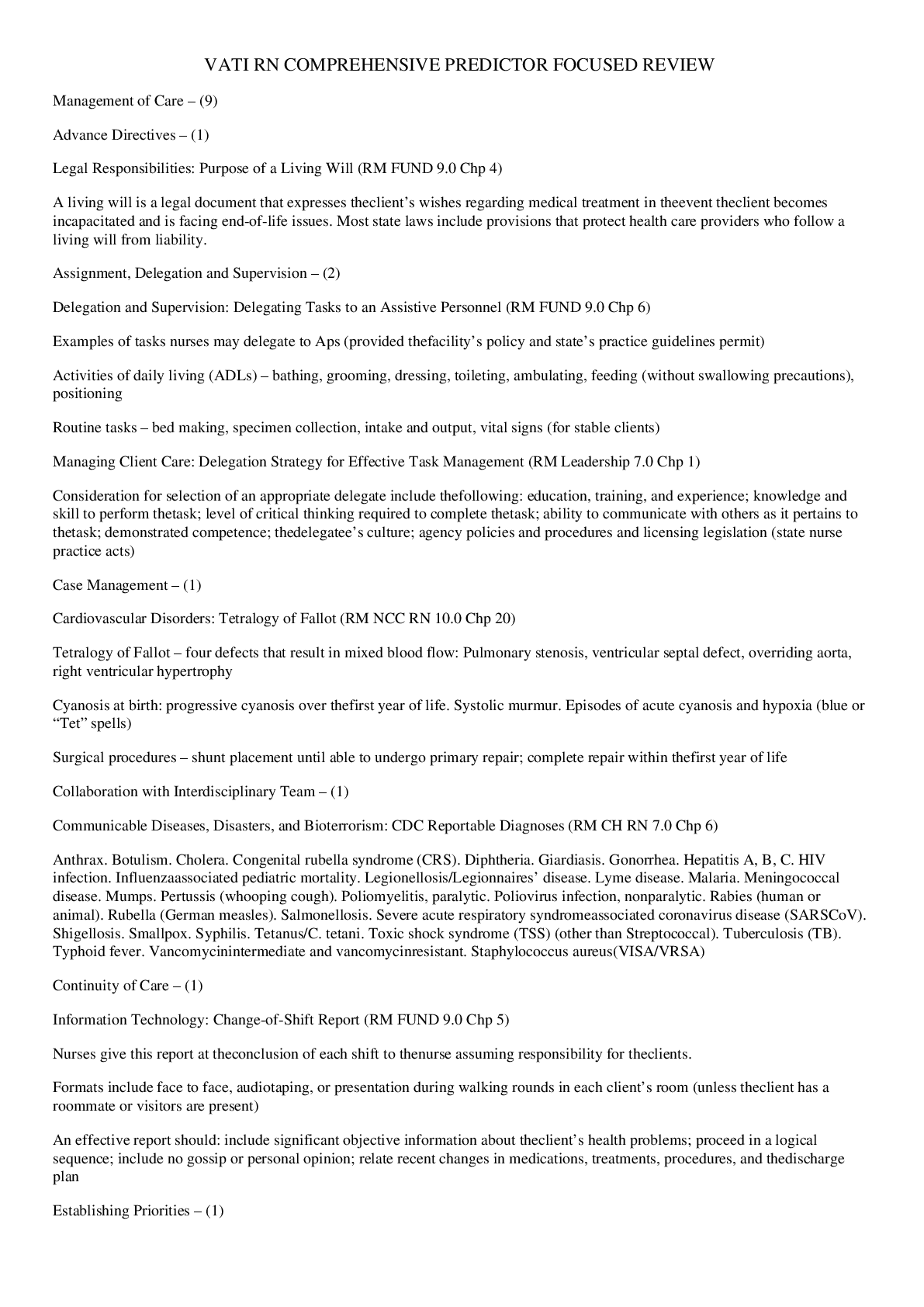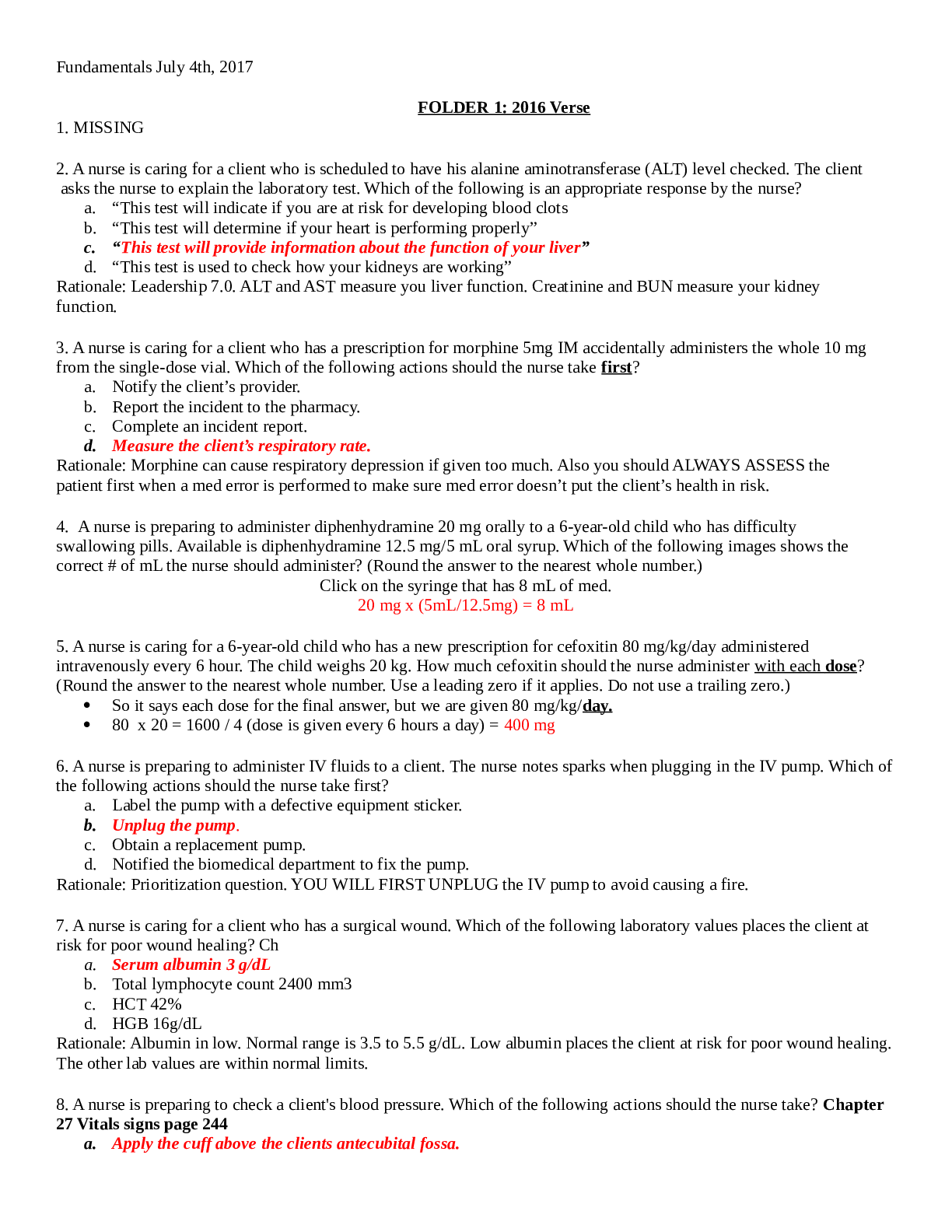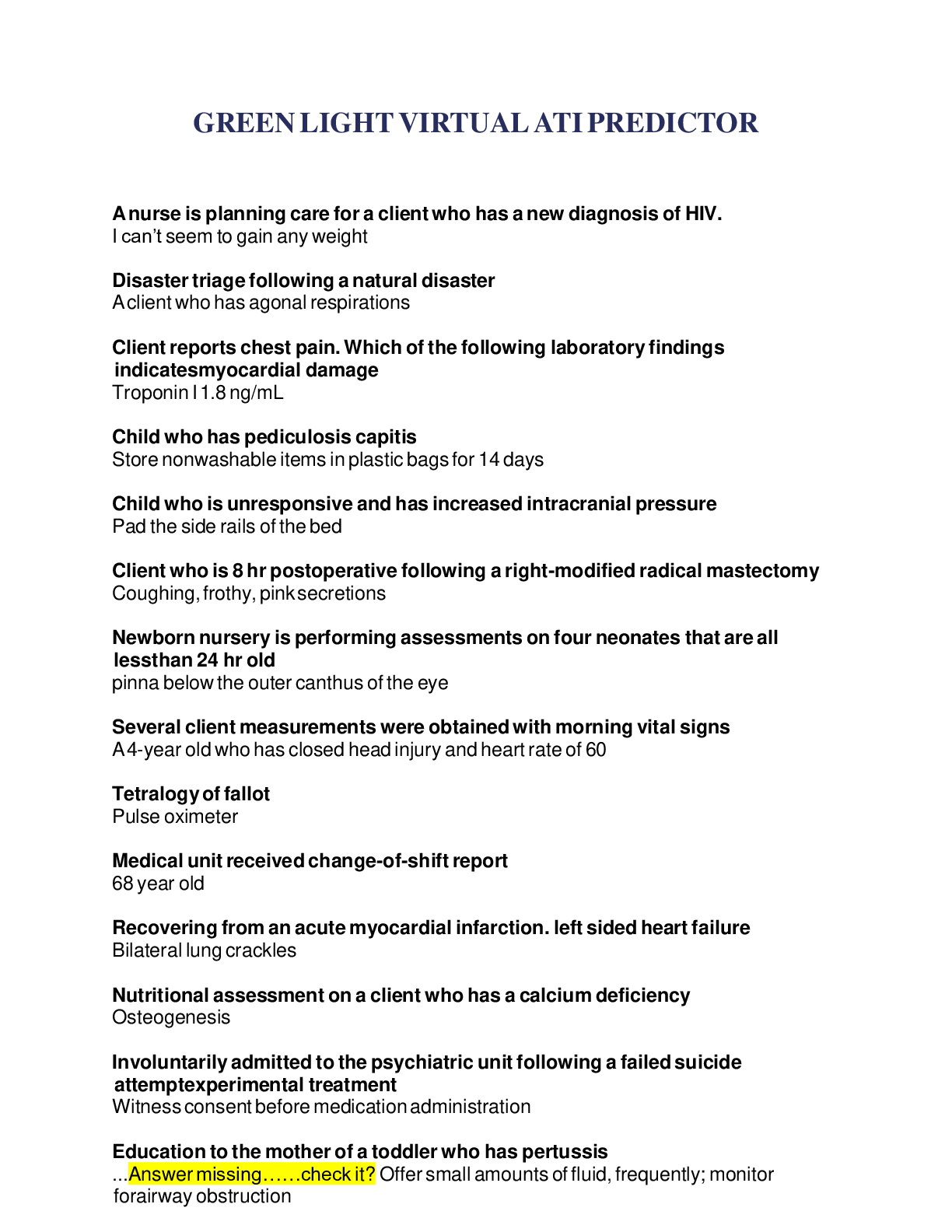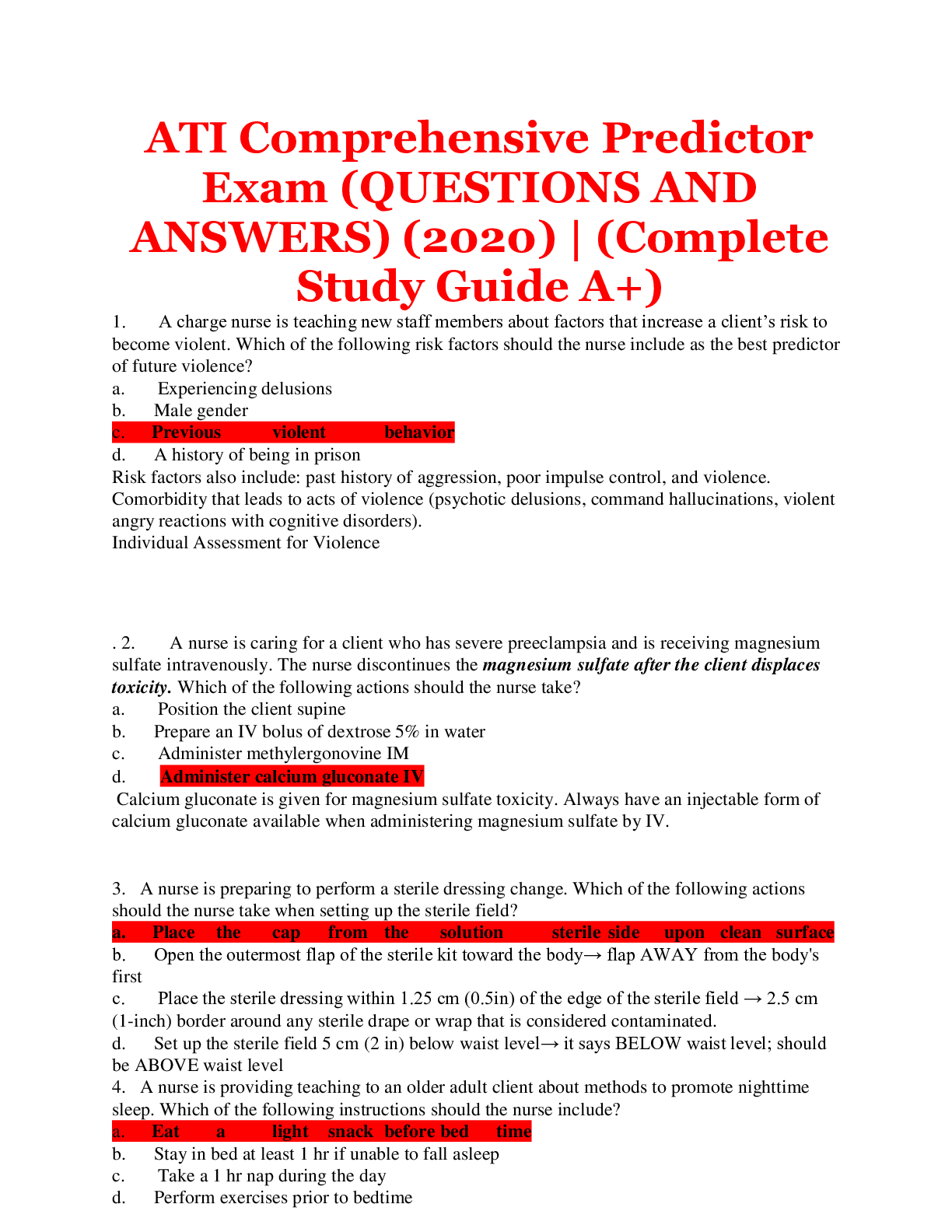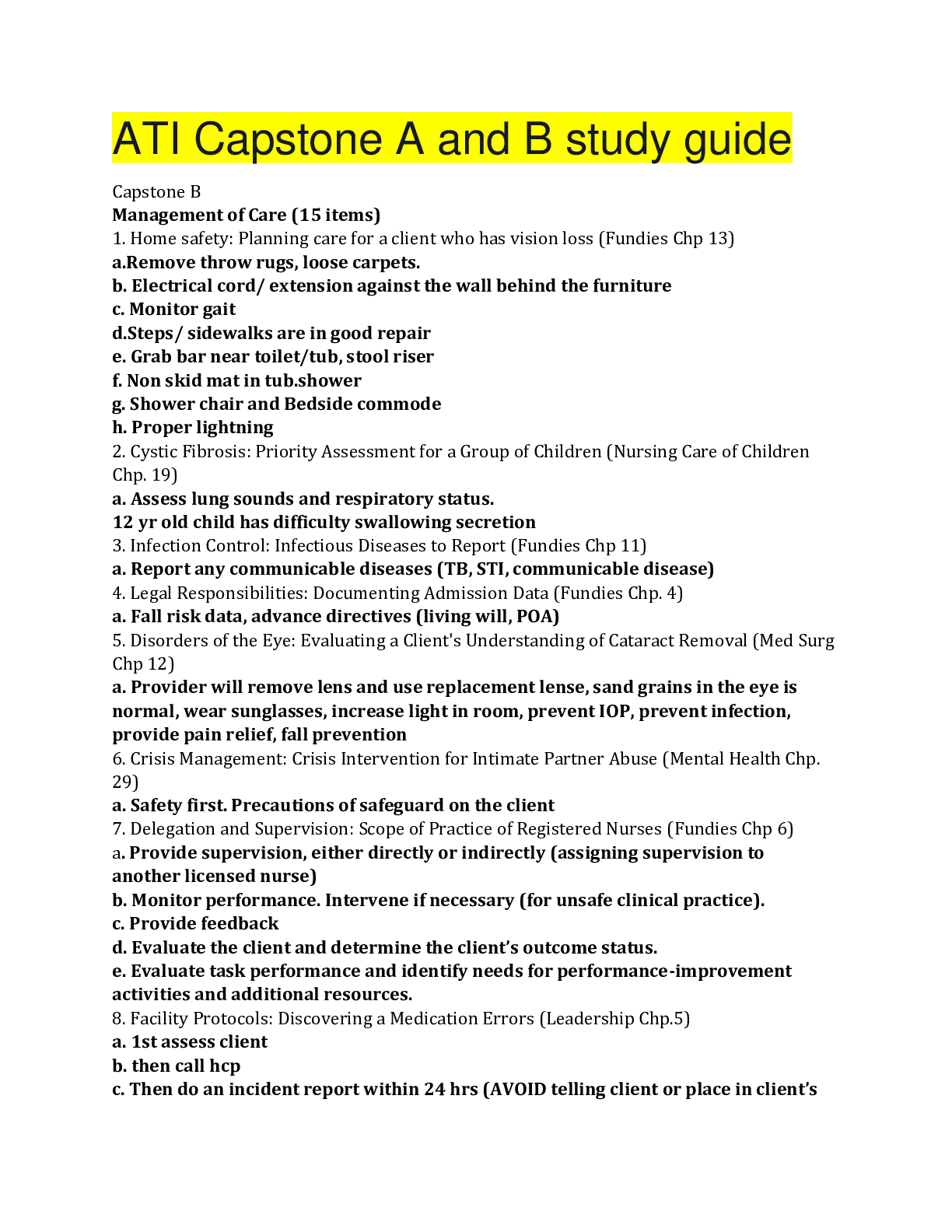*NURSING > QUESTIONS and ANSWERS > VATI RN COMPREHENSIVE PREDICTOR FOCUSED REVIEW__This document contains 17 pages of well arranged con (All)
VATI RN COMPREHENSIVE PREDICTOR FOCUSED REVIEW__This document contains 17 pages of well arranged content for eam review, organised for eased readability and reference.
Document Content and Description Below
VATI RN COMPREHENSIVE PREDICTOR FOCUSED REVIEW Management of Care – (9) Advance Directives – (1) Legal Responsibilities: Purpose of a Living Will (RM FUND 9.0 Chp 4) • A living ... will is a legal document that expresses the client’s wishes regarding medical treatment in the event the client becomes incapacitated and is facing end-of-life issues. Most state laws include provisions that protect health care providers who follow a living will from liability. Assignment, Delegation and Supervision – (2) Delegation and Supervision: Delegating Tasks to an Assistive Personnel (RM FUND 9.0 Chp 6) • Examples of tasks nurses may delegate to Aps (provided the facility’s policy and state’s practice guidelines permit) • Activities of daily living (ADLs) – bathing, grooming, dressing, toileting, ambulating, feeding (without swallowing precautions), positioning • Routine tasks – bed making, specimen collection, intake and output, vital signs (for stable clients) Managing Clie • Prioritizing the care of a client who has a new injury/illness (e.g. mental confusion, chest pain) or an acute exacerbation of a previous illness over the care of a client who has a long-term chronic illness • Prioritize actual problems before potential future problems • Prioritizing administration of medication to a client experiencing of Abuse/Neglect – (1) Family Violence: Evaluating Child Abuse (RM MH RN 10.0 Chp 32) • Infants – shaken baby syndrome: shaking can cause intracranial hemorrhage. Assess for respiratory distress, bulging fontanels, and an increase in head circumference. Retinal hemorrhage can be present. Any bruising on an infant • suspicious. Assess for human bite marks. Assess for head injuries, level of consciousness, equal and reactive pupils, and nausea or vomiting. Mental Health Concepts – (2) Anxiety Disorders: Expected Findings for a Client who has Social Anxiety Disorder (RM MH RN 10.0 Chp 11) Basic Care and Comfort – (3) Assistive Devices – (1) Sensory Perception: Speaking to a Client Who Has a Hearing Impairment (RM FUND 9.0 Chp 45) Mobility/Immobility – (1) Musculoskeletal Trauma: Skeletal Traction (RM AMS RN 10.0 Chp 71) Nutrition and Oral Hydration – (1) Renal Disorders: Dietary Prevention of Nephrolithiasis (RM Nutrition 6.0 Chp 14) • The most common type of kidney stone is made of calcium oxalate. Contributing • Therapeutic nutrition – increasing fluid consumption is the primary intervention Pharmacological and Parenteral Therapies – (7) Adverse Effects/Contraindications/Side Effects/Interactions – (1) Medications for Psychotic Disorders: Screening for Extrapyramidal Adverse Effects (RM MH RN 10.0 Chp 24) • diphenhydramine can also be beneficial. Stay with the client and monitor the airway until spasms subside (usually 5-15 min) • Pseudoparkinsonism – bradykinesia, rigidity, shuffling gait, drooling, tremors • of the tongue and face, such as lip smacking and tongue fasciculations. Involuntary movements of the arms, legs, and trunk • Nursing considerations – evaluate the client every 3 months, if TD appears, • Neuroendocrine effects – gynecomastia, weight gain, menstrual irregularities • Neuroleptic malignant syndrome – sudden high fever, blood pressure fluctuations, diaphoresis, tachycardia, muscle rigidity, drooling, decreased level of consciousness, coma, tachypnea • to the provider. The client can need dosage lowered or be switched to a high-potency agent • Skin effects – photosensitivity that can result in severe sunburn. Contact dermatitis from handling medications • Nursing considerations – Advise clients to avoid excessive exposure to sunlight, to use sunscreen, and to wear protective clothing. Advise clients to avoid direct contact with the education • Liver impairment • Nursing considerations – assess baseline liver function, and monitor Central Venous Access Devices – (1) Cardiovascular Diagnostic and Therapeutic Procedures: Care of the Nontunneled Expected Actions/Outcomes – (1) Medication Administration – (4) Bipolar Disorder: Teaching the Client About a Mood Stabilizer (RM Pharm RN 7.0 Chp 9) Brain Stimulation Therapies: Client Education About Electroconvulsive Therapy (RM MH RN 10.0 Chp 10) • Indication • Medication Management Any cardiac conditions, such as dysrhythmias or hypertension, should be monitored and treated before the procedure The nurse monitors vital signs and mental status before and after the ECT procedure The nurse assess the client’s and family’s understanding and knowledge of Cystic Fibrosis: Client Teaching about Pancrelipase (RM NCC RN 10.0 Chp 19) • Pancrelipase treats pancreatic insufficiency associated with cystic fibrosis • Nursing considerations – monitor stools for adequate dosing (1-2 stools/day). Administer capsules with all meals and snacks. Client can swallow or sprinkle Reduction of Risk Potential – (6) Potential for Complications of Diagnostic Tests/Treatments/Procedures – (2) Cardiovascular Diagnostic and Therapeutic Procedures: Priority Intervention Postangiography (RM AMS RN 10.0 Chp 27) • Nursing Actions – assess vital signs every 15 min x 4, every 30 min x 2, every hour x 4, and then every 4 hr (Follow facility protocol). Assess the groin site at • Client education – instruct the client to do the following (leave the dressing in • Complications • Cardiac tamponade – can result form fluid accumulation in the pericardial sac Nursing actions – notify the provider immediately. Administer IV fluids to • Hematoma formation – blood clots can form near the insertion site • Restenosis of treated vessel – clot reformation in the coronary artery can occur immediately or several weeks after procedure • Retroperitoneal bleeding – bleeding into retroperitoneal space (abdominal cavity behind the peritoneum) can occur due to femoral artery puncture Disorders of the Eye: Identifying Postoperative Risk (RM AMS RN 10.0 Chp 12) Potential for Complications from Surgical Procedures and Health Alterations – (1) Pituitary Disorders: Clinical Findings of Diabetes Insipidus (RM AMS RN 10.0 Chp 77) System Specific Assessments – (1) Head Injury: Assessing Decerebrate Posturing (RM AMS RN 10.0 Chp 14) Therapeutic Procedures – (2) Cancer Disorders: Client Discharge Education for Ileal Conduit (RM AMS RN 10.0 Chp 92) Skin Infections and Infestations: Home Care of Pediculosis Capitis (RM NCC RN 10.0 chp 30) Physiological Adaptations – (5) Alterations in Body Systems – (1) Pituitary Disorders: Client Comfort (RM AMS RN 10.0 Chp 77) • . Hemodynamics – (1) Electrocardiography and Dysrhythmia Monitoring: Identifying the Need for Medical Emergencies – (1) Emergency Nursing Principles and Management: Priority Assessment (RM AMS RN 10.0 Chp 2) Unexpected Response to Therapies – (2) • [Show More]
Last updated: 1 year ago
Preview 1 out of 17 pages
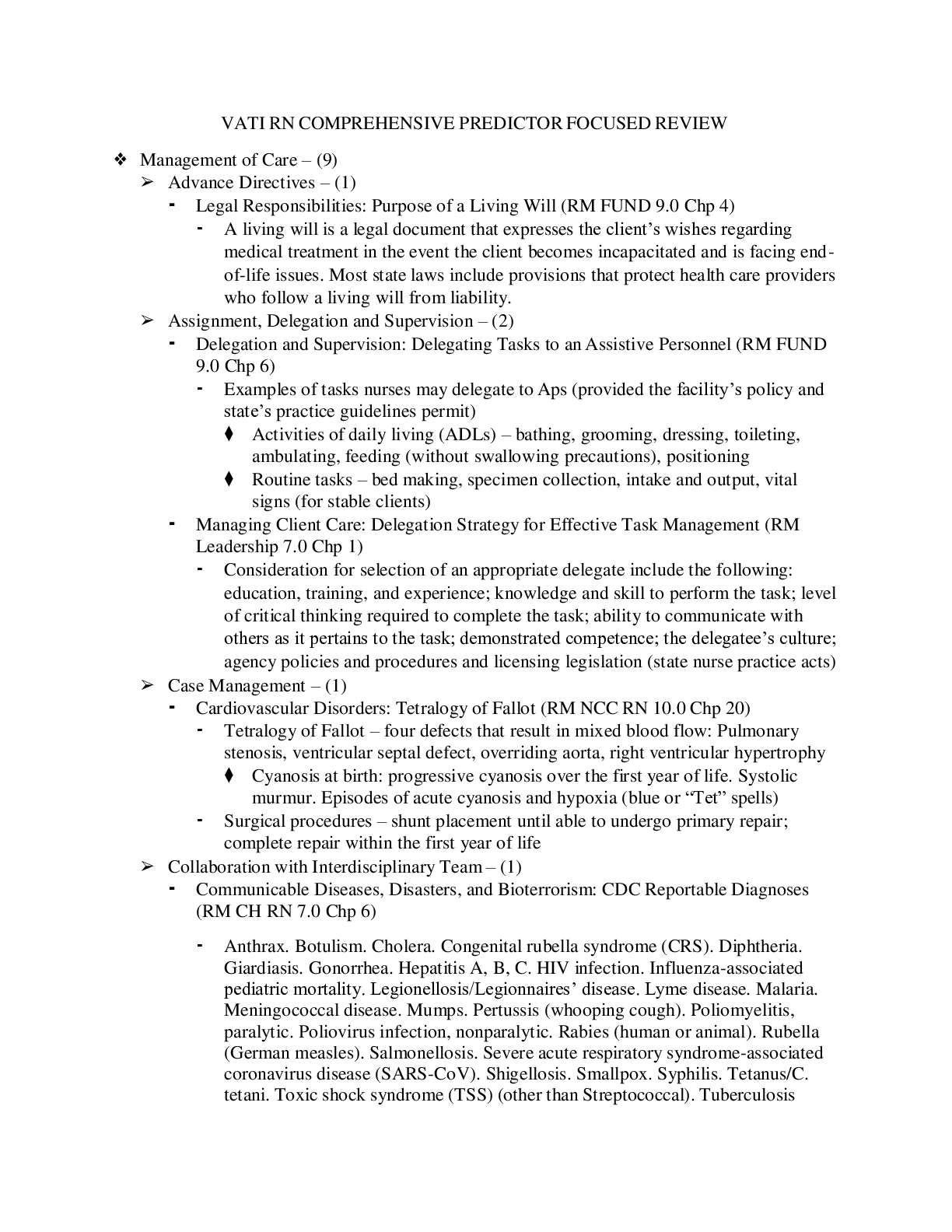
Reviews( 0 )
Document information
Connected school, study & course
About the document
Uploaded On
Dec 19, 2020
Number of pages
17
Written in
Additional information
This document has been written for:
Uploaded
Dec 19, 2020
Downloads
0
Views
64



